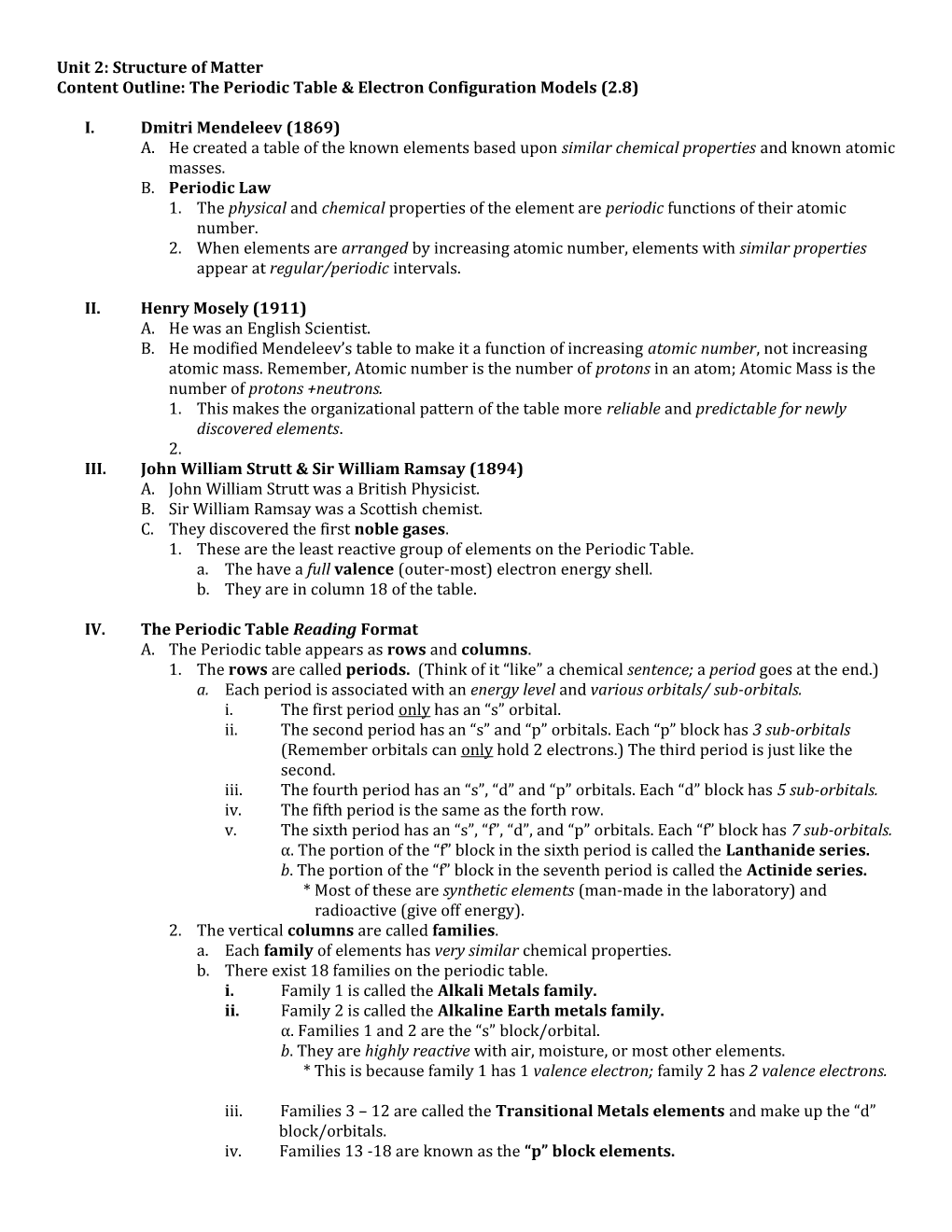Unit 2: Structure of Matter
Content Outline: The Periodic Table & Electron Configuration Models (2.8)
- Dmitri Mendeleev (1869)
- He created a table of the known elements based upon similar chemical properties and known atomic masses.
- Periodic Law
- The physical and chemical properties of the element are periodic functions of their atomic number.
- When elements are arranged by increasing atomic number, elements with similar properties appear at regular/periodic intervals.
- Henry Mosely (1911)
- He was an English Scientist.
- He modified Mendeleev’s table to make it a function of increasing atomic number, not increasing atomic mass. Remember, Atomic number is the number of protons in an atom; Atomic Mass is the number of protons +neutrons.
- This makes the organizational pattern of the table more reliable and predictable for newly discovered elements.
- John William Strutt & Sir William Ramsay (1894)
- John William Strutt was a British Physicist.
- Sir William Ramsay was a Scottish chemist.
- They discovered the first noble gases.
- These are the least reactive group of elements on the Periodic Table.
- The have a fullvalence (outer-most) electron energy shell.
- They are in column 18 of the table.
- The Periodic Table Reading Format
- The Periodic table appears as rows and columns.
- The rows are called periods. (Think of it “like” a chemical sentence; a period goes at the end.)
- Each period is associated with an energy level and various orbitals/sub-orbitals.
- The first period only has an “s” orbital.
- The second period has an “s” and “p” orbitals. Each “p” block has 3 sub-orbitals (Remember orbitals can only hold 2 electrons.) The third period is just like the second.
- The fourth period has an “s”, “d” and “p” orbitals. Each “d” block has 5 sub-orbitals.
- The fifth period is the same as the forth row.
- The sixth period has an “s”, “f”, “d”, and “p” orbitals. Each “f” block has 7 sub-orbitals.
α. The portion of the “f” block in the sixth period is called the Lanthanide series.
b. The portion of the “f” block in the seventh period is called the Actinide series.
* Most of these are synthetic elements (man-made in the laboratory) and
radioactive (give off energy).
- The vertical columns are called families.
- Each family of elements hasvery similar chemical properties.
- There exist 18 families on the periodic table.
- Family 1 is called the Alkali Metals family.
- Family 2 is called the Alkaline Earth metals family.
α. Families 1 and 2 are the “s” block/orbital.
b. They are highly reactive with air, moisture, or most other elements.
* This is because family 1 has 1 valence electron; family 2 has 2 valence electrons.
iii. Families 3 – 12 are called the Transitional Metals elements and make up the “d”
block/orbitals.
iv. Families 13 -18 are known as the “p” block elements.
α. These elements are a collection of metals, metalloids, non-metals, and gases.
* The metalloids are next to the zigzag line running down through the “p”
block in the table.
b. The “s” and “p” blocks collectively together are referred to as the main-group
elements.
c. The family in column 17 is known as the Halogen family.
* They are very reactive elements as they are missing1 electron from having
a full valence shell.
d. The family in column 18 is known as the Noble gases.
* These are the leastreactive elements on the table, as they possess a full
valence shell known as an “octet” or 8 electrons in a shell.
- Metals
- These make up the majority of the Periodic Table.
- Metals are defined as good conductors of electricity, have a high luster (shine) and are malleable (capable of being beat, using hammers or rollers, into wires).
4. Metalloids (“oid” means “like a”)
a. These are “like” metals as some are able to conduct some electricity (A.K.A. as semi-
conductors).
b. They are located between the metals and the gases along the zigzag line of “p” block.
5. Non-metals
a. These are mostly powders that are non-conductors of electricity.
6. Gases
a. These floating elements that have no definite shape or volume. They take the shape and
volume of their container.
b. Most can conduct electricity. (Remember the Cathode-Ray tubes and neon signs.)
